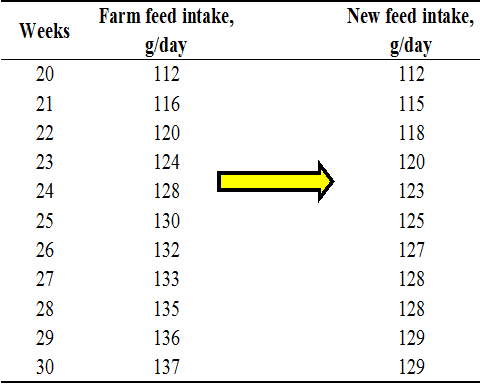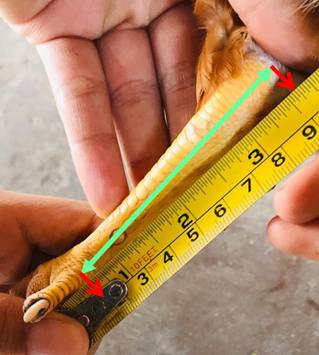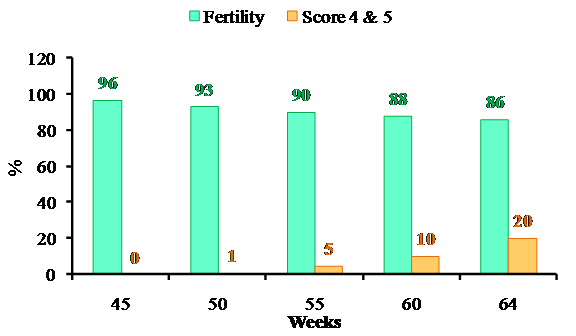How to Improve the Fertility and Hatchability in Broiler Breeders
Sandro Cerrate, PhD
Credinser LLC, Madison, Alabama
Published: January 25, 2020
In some companies, fertility and hatchability start to decrease during the last weeks of production, for example after 50 weeks, at the same time there is a loss of feathers in the back or there is an overweight of the egg. How can we improve fertility and hatchability in the last phase of production of broiler breeders? To improve fertility and hatchability we must evaluate three important points: (a) management of the roosters, (b) hen feather cover and (c) egg size.
a) Management of the roosters
The feeding management of the roosters during the first four weeks and after 20 weeks of age is crucial to have an ideal bone conformation and to control their overweight since the start of photostimulation. Roosters with overweight or with a high incidence of mating will wear the feathers early in young hens, losing the first back feathers before the 40 weeks of age, and thereby losing a greater number of feathers in the back after 50 weeks and for this reason avoiding the mating activity. These feathers conditions could be further aggravated if the roosters have an excess of libido, so the percentage of males per female will have to be evaluated.
Overweight roosters during the first weeks of production will have a good testicular development and great libido, but after 35 weeks the testicular weight decreases physiologically as birds age, and also managers at seeing a rapid overweight roosters after 30 weeks restricts the feed intake, and as a result, the gain in live weight and testicular weight will be reduced, affecting negatively the persistence of fertility. Therefore, a practical way to manage the rooster’s feed intakes after 20 weeks of age is by the calibration of the new feed consumption for the following flocks of roosters. To illustrate, the calibration needs information on the historic feed intake, live historic weights, and target weights. How is this calibration performed? First, an equation between feed consumption and live weight of the farm is developed using a logarithmic relationship as shown in Figure 1 and described as follows.
Farm feed consumption, g / day = 54.305LN (Farm Live Weight, g) -323.12;
Second, this model is then used to calculate the New feed consumption from the target Live Weight, as shown in Table 1:
New feed consumption, g / day = 54.305LN (Target live weight, g) -323.1;
Figure 1. Relationship between farm feed intake and body weight during 20-30 weeks.

Table 1. Farm feed intake and new feed intake.

This equation is applicable only for the specific management, environmental, and nutritional conditions of the farm; this should be recalibrated at least every 6 months because the management conditions and genetic progress could be changed. If after 30 weeks the roosters have an ideal body weight profile, the weekly weight gain, ~ 20-35 grams per week, can be better controlled or managed. On the contrary, if you handle overweight and short roosters, the mating activity will be reduced. Roosters with less than 10 cm of shank length (Figure 2) could have problems during the mating, for instance. Moreover, roosters with small shank will also have a small head and crest, and their heads can easily enter the female track feeders. Particularly, roosters with weights 15% less than the recommended value at four weeks will have a head and bent crest height less than 60 cm at 25 weeks increasing the probability of eating the female feed since the roosters could go through the grills.
On the contrary, roosters with weights of 800 grams or more at four weeks will have a height of head and bent crest greater than 60 cm, thus avoiding eat the hen feed and reducing overweight. Hence, to obtain roosters of optimum height, it is recommended from the beginning to select birds of great height and genetic potential, with a minimum weight of 800 grams and a minimum shank length of 60 cm at four weeks. Likewise, a diet for males will also help to control the male body weight by feeding them with low-protein diets, about 11.5%, or a digestible lysine level of 0.44%. Furthermore, to increase the male feed volume and avoid the anxiety of feeding the hen feed, a low energy density diet, 2,700 kcal/kg, is recommended. This diet is preferable to be administrated from the photostimulation to control the overweight of the roosters.
Figure 2. Shank length.

Note: The length of the shanks is measured from the top of the flexed hock joint to the base of the rear toe as shown in the green line.
b) Hen feather cover
It is important to strengthen and evaluate the development of the feathers from the rearing period to the production period. The quality of feathers in the pullets can be monitored by scoring the wing feathers which will indicate that the consumption of amino acids was properly balanced. Thus, balanced diets in amino acids will improve the feathers in the rearing period and consequently will carry over into the production phase. Another effective way to improve the feathers is to increase the amount of insoluble fiber from the rearing period, which will improve the feathers in the rearing, and then in the production period (Morrissey et al. 2014). Similarly, during the production period, both amino acid balance (Cerrate et al. 2019) and fiber will also affect the feather cover. Further, before analyzing the dietary nutrients, the feeder space should be evaluated because this has a crucial impact on the development of feathers. As an illustration, hens with restricted feeder space (<15cm per hen in a linear feeder) easily lose the feathers in the back and these are recognized because the feathers of the back are reduced in size and change from a white color to a gray or lead color.
In addition, if hens are fed with pan feeders, they should have a space of 10 cm/hen, and it will be necessary to observe how the feed is distributed or not and whether the birds eat evenly or they are grouping without reaching the feed. On the other hand, in production, the fertility and feathers must be monitored, by measuring the conditions of the feathers in the back, in order to take actions on management and feeding. For instance, if the hens have a percentage of feathers of score 4 and 5 greater than 5% at 55 weeks (Figure 3), managers will have to evaluate the management of the roosters, feeder space, and the balance of amino acids and fiber levels.
Figure 3. Fertility and maximum back feather score.

Note: Score 4 & 5 = Score 4 + Score 5. Score 4 represents hens with 4 inches or 10.1 cm of bare back, considering the length of denuded back from cranial to tail (caudal) direction. Score 5 represents hens with 5 inches or 12.7 cm of bare back.
c) Egg size
Overweight eggs decrease fertility and hatch of fertile eggs (Malik et al. 2015) because of thickness of the eggshell decreases (Liao et al. 2013), and the incidence of microcracks increases. Therefore, controlling the overweight of eggs is key for improving the hatchability. In other words, if the egg weight is greater than 70 grams at 60 weeks, the nutrients and feed intake should be analyzed. The fastest way for controlling the weight of the eggs is by feeding hens with properly balanced amino acids, among them the lysine should be restricted since its excess will result in breast enlargement, and consequently the egg size will also increase as well resulting in a loss of hatchability. Moreover, if lysine is fed in excess, it will be deposited in the muscle, and the other amino acids will also be deposited in the muscle resulting in reduced deposition of cysteine, arginine, and valine in the feathers, and consequently affecting negatively the feather cover and fertility. Additionally, in hens fed with excess protein or amino acids, the breast muscle weight and hardness increases, being this latter, a characteristic easily recognized by manual palpation.
In contrast, if lysine is reduced for controlling the egg weight, the other amino acids such as cysteine, arginine, and valine should be increased to strengthen the feathers. In other words, there must be an amino acid balance to control breast muscle growth and improve feather quality (Figure 4). In different circumstances, high levels of fiber will also prevent hens from laying overweight eggs. As an example, in the laying period, the dietary crude fiber could be increased up to 6.0% but the dietary soluble fiber should be restricted to a maximum of 3.5%. When these nutrients are taken into account, the genetics of the bird and environment temperature will have to be evaluated since broiler breeder hens under heat stress conditions reduce the size of the egg, and some breeder hen lines tend to increase the egg size more than other genetic lines.
Figure 4. Balance of nutrients between breast muscle meat and feathers.

Conclusions:
- Avoid overweight male broiler breeders from the photostimulation to 30 weeks of age by calibrating the feed consumption. To obtain roosters of controlled weight, good size, and ideal bone conformation, it is essential to reach an ideal body weight profile and height of the shanks at four weeks of age.
- Monitor the feather quality from the rearing to the production phase. After verifying the feeder space, the amino acid balance and fiber level can be analyzed to improve the feather cover.
- To control the egg size and to improve the fertility and hatchability, the level of digestible lysine should be restricted. Besides, the level of fiber is key to control an egg overweight. The environmental temperature and genetic of the bird should be taken into account as these affect the egg size.
References:
Conflict of Interest and disclaimer
The author declares that this article was conducted in the absence of any commercial or financial relationships that could be construed as a potential conflict of interest. Every attempt has been made to ensure that the material in this article is accurate, true, correct, and relevant at the time of writing. However, the author accepts no liability for any omissions, damage, loss, or financial consequences of using this article.


